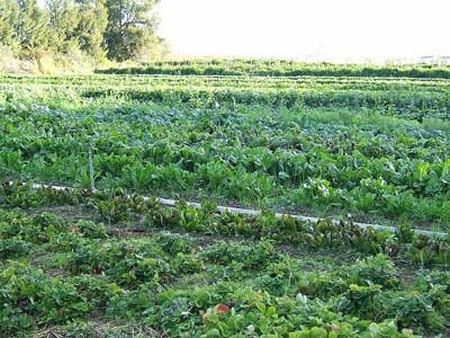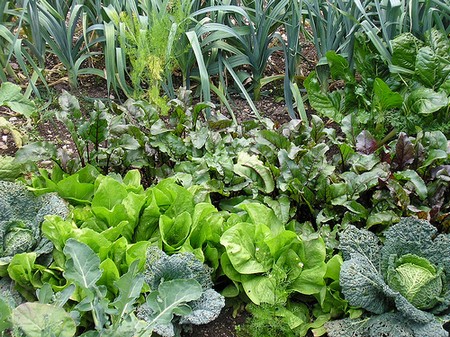Best Way to Fertilize Vegetable Organically
Vegetables grow fast compared with many other plants and need a readily available supply of nutrients while they are growing. Garden soil contains most of the essential minerals plants need for growth but the following three major nutrients are needed in relatively large quantities. Major nutrients Nitrogen makes plant proteins including chlorophyll, which gives plants their green color. Lack of nitrogen slows growth and yellows the leaves; later, the stems may be an unnatural red or purple. The nitrogen used by plants is in a soluble form (nitrates or ammonium salts) so it is easily washed out of the soil during heavy rain. Free-draining soils such as sandy or chalky soils are most likely to leave plants short of nitrogen.
Phosphorus is important for growth and respiration. It is needed in the form of soluble phosphates for the formation of plant organs such as roots.
Potassium, in the form of potash, acts as a regulator in plant cells and also affects the size and quality of flowers and fruits.
Both phosphorus and potassium are usually present in sufficient quantities in garden soils. If in doubt, send a soil sample to be analysed -this will tell you if any is in short supply, as well as the pH, which can affect plants’ ability to absorb nutrients. You can also ask for the soil’s organic content to be analysed at the same time. The analysis should give advice on correcting any nutrient deficiencies.
Sources of nutrients
Organic matter added to improve the structure of the soil will also contribute to soil fertility. However, the quantities of nutrients present in organic matter is variable. Manure contains a reasonable amount of nitrogen; 1kg of cow or horse manure could contribute as much nitrogen as 25g of growmore. On the other hand, leafmould and bark chips contribute very little useable nutrient, and woodchips can actually remove nitrogen from the soil.
If you do need to add potash or phosphate, choose between the naturally occurring rock potash or bonemeal, which are acceptable to organic gardeners, or the man-made sulphate of potash or superphosphate.
The organic approach is to feed the soil with organic matter rather than rely on fertilizers. If your soil is low in nutrients and you cannot add sufficient organic matter, fertilizers offer a quick and easy way to supply your plants’ needs. It is important to supply sufficient fertilizers for heavy feeders, such as brassicas and maincrop potatoes, but not too much as nutrients can be washed out of the soil by rain and contribute to pollution.
Applying fertilizer
Most fertilizers are sold as powders or granules. Rather than apply all the fertilizer to the growing vegetable in one go, spread the dose throughout the growing season. Typically, about half the amount is raked or forked into the soil before sowing or planting. The rest is then applied when the crop is halfway to maturity.
Liquid feeds are essential for crops growing in containers or for getting nutrients to plants quickly. Liquid feeds for leafy crops are balanced, e.g. liquid growmore, but the most widely sold liquid fertilizer is tomato feed, which is high in potash to encourage fruit production.
Minor nutrients
The only other nutrient to worry about is magnesium. Lack of this shows up as yellowing between the veins on leaves of tomatoes, especially growing in containers. Look for a tomato feed which includes magnesium or water with a solution of Epsom salts (about 200g to 10 litres of water). Liquid feeds or fertilizers containing seaweed extract are a good source of all the other minor elements, manganese, boro
Categories
Advertisements
Recent Articles
 How to Understand Bed Sizes – A Small Guide
How to Understand Bed Sizes – A Small Guide How to Select Some Must Have Kitchen Accessories
How to Select Some Must Have Kitchen Accessories Best Way to Change a Car Tire
Best Way to Change a Car Tire Best Way to Write an Affirmation
Best Way to Write an Affirmation Best Way to Take Charge of Your Financial Life
Best Way to Take Charge of Your Financial Life Best Way to Survive a Party When You Don’t Know Anyone
Best Way to Survive a Party When You Don’t Know Anyone Best Way to Stop Self Sabotaging Yourself
Best Way to Stop Self Sabotaging Yourself Best Way to Start Journal Writing
Best Way to Start Journal Writing Best Way to Speak with a Powerful Voice
Best Way to Speak with a Powerful Voice Best Way to Simplify Your Life
Best Way to Simplify Your Life Best Way to Respond to a Put-Down
Best Way to Respond to a Put-Down Best Way to Reduce Acne Breakouts
Best Way to Reduce Acne Breakouts Best Way to Recover from Dining Disasters
Best Way to Recover from Dining Disasters Best Way to Quit Your Job Gracefully
Best Way to Quit Your Job Gracefully Best Way to Make Your Own Website
Best Way to Make Your Own Website



Leave a Reply